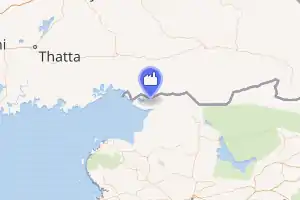Gujarat Hybrid Renewable Energy Park
The Gujarat Hybrid Renewable Energy Park is an under construction renewable energy park located near Vighakot village near Kutch district of Gujarat, India. It is expected to generate 30 gigawatt electricity from both solar panels and wind turbines when completed, over an area of 72,600 hectares (726 km2).
| Gujarat Hybrid Renewable Energy Park | |
|---|---|

| |
| Country | India |
| Location | Vighakot, Kutch district, Gujarat |
| Coordinates | 24.21534102°N 69.19548725°E |
| Status | Under construction |
| Construction began | 15 December 2020 |
| Construction cost | ₹150,000 crore (US$21 billion) |
| Solar farm | |
| Type | Flat-panel PV |
| Wind farm | |
| Type | Onshore |
| Site usage | Wasteland |
| Site area | 72,600 ha (726 km2) |
| Power generation | |
| Units planned | 1 × 30000 MW |
| Nameplate capacity | 30000 MW |
Project
When completed, the park will generate 30 gigawatt electricity from both solar panels and wind turbines. It will spread over an area of 72,600 hectares (726 km2) of waste land.[1][2] When completed, it will be the biggest hybrid renewable energy park in the world.[1]
The composition of the park will be as follows:
| Zones | Total land (hectares) | Developers | Allocated land (hectares) | Production capacity (MW) |
|---|---|---|---|---|
| Hybrid wind-solar power zone | 49,600 | Adani Green Energy | 19,000 | 9,500 |
| Sarjan Realities (Suzlon) | 9,500 | 4,750 | ||
| NTPC | 9,500 | 4,750 | ||
| Gujarat Industries Power Company | 4,750 | 2,375 | ||
| Gujarat State Electricity Corporation | 6,650 | 3,325 | ||
| Wind power zone | 23,000 | Solar Energy Corporation of India will invite competitive bidding | 23,000 | - |
The developers are obligated to install 50% of their allocated capacity by 2023 and complete the project by 2025. The Power Grid Corporation of India will manage the electric power transmission.[3] The park is expected to generate one lakh jobs and attract an investment of ₹150,000 crore (US$21 billion). It also accounts for 5 crore tonnes carbon emission reductions each year.[1]
History
The proposal of the park was approved by the Government of Gujarat on 9 September 2020, allocating 60,000 hectares (600 km2) of land. The proposal had mentioned total 41.5 gigawatt capacity.[4] The foundation stone of the project was laid on 15 December 2020 by Indian Prime Minister Narendra Modi.[1][2]
See also
References
- "Bigger than Singapore, Bahrain! World's biggest, hybrid renewable energy park in Gujarat to attract huge investment!". The Financial Express. 2020-12-16. Retrieved 2020-12-19.
- "Gujarat to get India's largest renewable energy generation park". ETEnergyworld.com. 2020-12-14. Retrieved 2020-12-22.
- "Explained: A look at India's sprawling renewable energy park, coming up on its border with Pakistan". The Indian Express. 2020-12-10. Retrieved 2020-12-22.
- "Proposal for 41.5 GW Hybrid Renewable Park in Kutch Approved". www.saurenergy.com. Retrieved 2021-01-06.